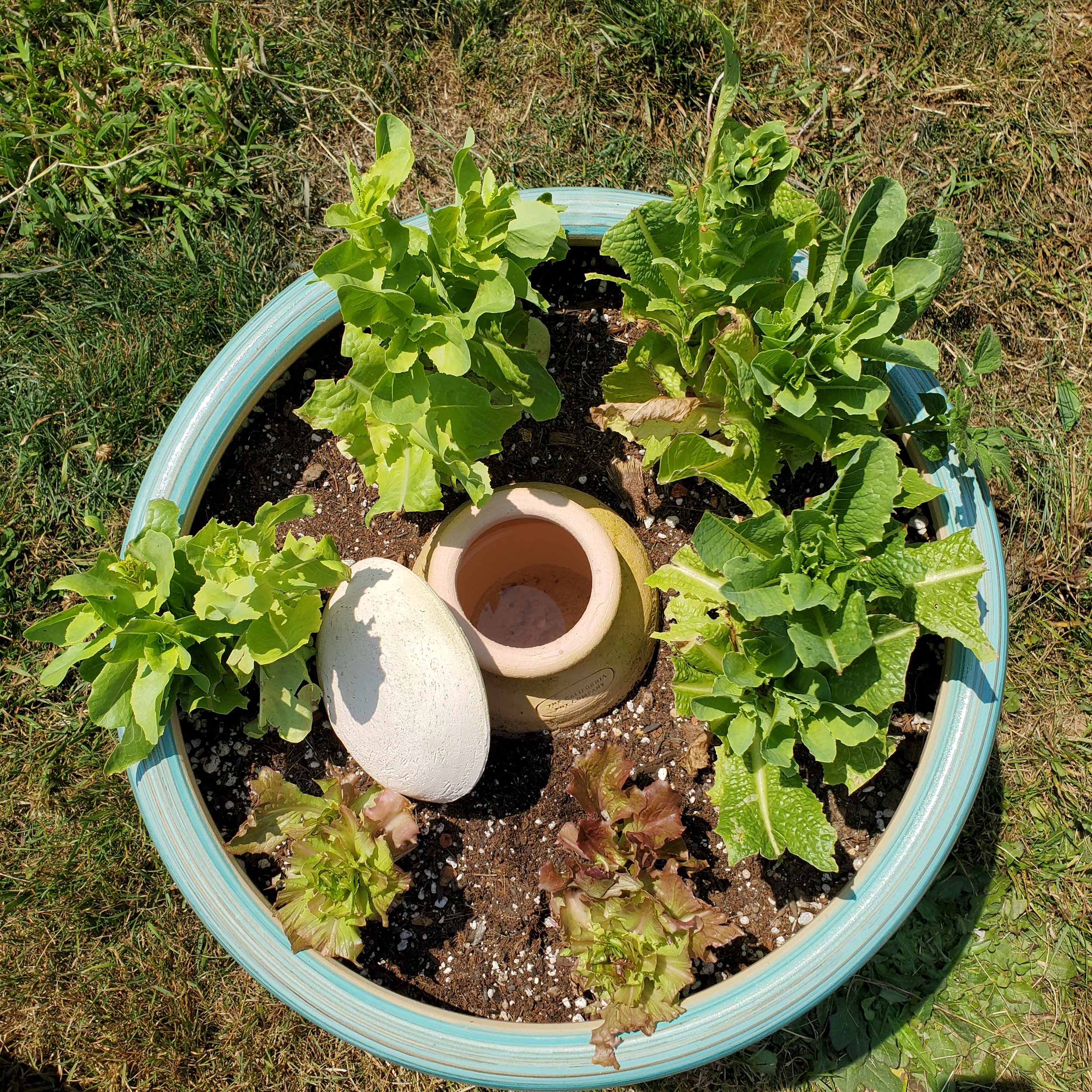Buried Clay Irrigation Pots
Buried clay pot irrigation is a super-efficient method of watering plants. Historically this watering method developed in hot, dry climates as an efficient way to water crops. This technique was documented over 2,000 years ago in China by agronomist Fan Shengzhi. Today, in the Americas, they are often referred to as "ollas" or "oyas;"
This type of irrigation is popular today because of it many benefits.
Works great for strawberries!
Benefits of Buried Clay Pot Irrigation
Conserve Water: Reduce evaporation and overwatering, using up to 90% less water than traditional top-watering!
Save Time: Fill pots less often, with intervals of up to three weeks between fillings, even during dry seasons.
Maintain Moisture While Away: Keep plants hydrated during vacations without worry.
Reduce Weeds and Disease: Avoid surface watering, which encourages weed growth and fungal infections.
Boost Germination and Growth: Ensure consistent moisture for healthy root development.
Control Pests: Minimize the damp environments that attract slugs and snails while also making them easy to locate and remove when they gather around the pots.
Works great potted plants, like this pepper.
How Irrigation Pots Work
Porous ceramic pots are buried with their openings exposed above the soil. Water gradually seeps through the walls of the pots, directly hydrating the roots and soil over several days, lasting up to two weeks. This method is even more efficient than drip irrigation. For an automated system, irrigation lines can be attached to the pots for easier refilling.
Works great for potted shrubs like these huckleberries.
Where to Use Irrigation Pots
Irrigation pots are versatile and can be used in farms, food gardens, flower gardens, restoration sites, and for plant propagation.
They are very effective for growing a variety of foods like beans, broccoli, cabbage, lettuce, peas, tomatoes, peppers, squash and many other vegetables. They work great for berries, trees, shrubs and any plants with horizontal root systems. This technique ensures a consistent and regulated water supply directly to the root zone.
How to Install
Bury the pots as deep as possible, leaving an inch or two of the pot exposed above the soil. Prepare the soil thoroughly and add any amendments needed within the effective watering area. Cover the surface with straw or mulch to prevent evaporation. For best results, fully wet the soil around the pot before use in order to help the water dissipate further away from the pot. If the soil dries out, re-wet it thoroughly when refilling the pots.
Feeding Tips
We recommend only using water in the pots. Adding fertilizers or plant food can be unpredictable, so it's best to apply nutrients directly to the soil. It is normal for the pots to develop their own microbiome and rich surface over time. Usually, this won’t affect their performance but if excessive calcium and minerals build up, the pots can be cleaned with vinegar and scrubbed.
Freezing Weather Considerations
In regions with long winters or hard freezes, it's safest to remove and empty the pots to prevent damage from expanding frozen water. Alternatively, you may be able to leave the empty pots in the ground and cover them with straw or another insulating material for protection.
How to Plant Around Irrigation Pots
Plant seeds within a few inches of the pot and provide top watering until they germinate. Starts can be planted further out, but keep enough space for easy access to refill the pots when plants are mature. For trees, the pots can be removed once the roots are established, though over many years, tree roots may grow strong enough to crack the pots.
Selecting the Right Pot Size
In average soil conditions, our large irrigation pots cover areas up to 36 inches in diameter or containers of up to 40 gallons. Medium pots are suitable for similar coverage but work better in shallower containers. Small and mini pots are ideal for smaller containers or focused irrigation. The effective radius may vary based on soil composition, with sandier soils offering a smaller range and clay-heavy soils providing greater coverage.
Versatility
Our irrigation pots can be adapted to be used for a variety of purposes such as growing moss and other plants directly on the surface or to help propagate cuttings of other plants.
Irrigation lines are easily attached for a more automated watering system.
Irrigation pots are attached to 1.4” irrigation lines in this set up for growing tomatoes.
Thick and healthy cannabis roots of a small plant grown with an irrigation pot in a five-gallon pot. The roots formed a thick mat around the pot to in order to sip water through it.
Professional Quality
Professionals prefer our irrigation pots over other brands because of their superior design, performance and durability. Our pots have been tested and used extensively in a variety of settings like farms, orchards, restaurants, schools and community gardens.
We often provide discounts and donations for educational and community programs that contribute to growing food.
Moon Made Farms
Superfine Osteria
Our Irrigation Pots vs. others and DIY Options
Our pots will last for many years/decades if they are properly cared for. They are designed to with specific proportions, volume and porosity that contributes to their superiority. They will far outperform any homemade DIY alternatives such as glued terra cotta pots or plastic bottles with pinholes. These DIY options often have issues with porosity, toxicity, durability, and heat absorption.
Our pots are made here in the U.S.A. by trustworthy humans; they do not contain lead or other harmful contaminants often found in imported pottery.













